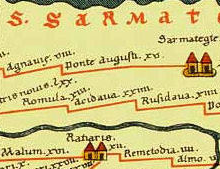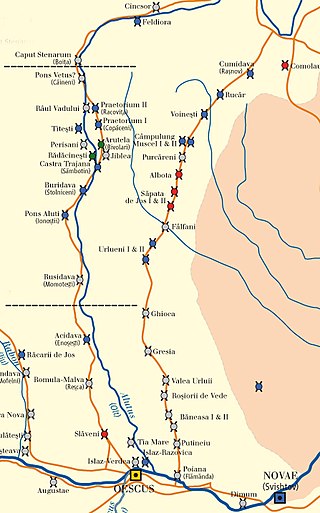
Sucidava was a Dacian and Daco-Roman city situated in Corabia, Romania, on the north bank of the Danube. It developed from the 270s AD and especially after the construction of Constantine's Bridge the northern side of which it protected.

The Moesian Limes is the modern term given to a linked series of Roman forts on the northern frontier of the Roman province of Moesia along the Danube between the Black Sea shore and Pannonia and dating from the 1st century AD. It was the eastern section of the so-called Danubian Limes and protected the Roman provinces of Upper and Lower Moesia south of the river. The eastern section is often called the limes Scythiae minoris as it was located in the late Roman province of Scythia Minor.

Limes Transalutanus is the modern name given to a fortified frontier system of the Roman Empire, built on the western edge of Teleorman's forests as part of the Dacian Limes in the Roman province of Dacia, modern-day Romania.

Acidava (Acidaua) was a Dacian and later Roman town and fort on the Olt river near the lower Danube. The settlement's remains are located in today's Enoşeşti, Olt County, Oltenia, Romania.

Arutela was an ancient Roman fort in the Roman province of Dacia today near the town Călimănești. It lies on the left bank of the Olt River. It was part of the Roman frontier system of the Limes Alutanus,

Praetorium II (Racovița) was a fort in the Roman province of Dacia near the present village of Racovița, Vâlcea. It was built in the middle of the 3rd century, part of the Roman frontier system of the Limes Alutanus along the Olt (river) and was the largest fort in the mountain area of the Limes.

Angustia was a fort in the Roman province of Dacia in the 2nd and 3rd centuries AD today near the town of Breţcu, Romania.

Castra Buridava was a fort in the Roman province of Dacia, part of the frontier system of the Limes Alutanus, and near the Dacian and Roman town of Buridava.

Jidava was a fort in the Roman province of Dacia 4 km southwest of the town of Campulung, Romania. It was built around 190–211 AD as part of the frontier system of the Limes Transalutanus located approximately 20 km south of the Rucăr-Bran pass.

Caput Stenarum was a fort in the Roman province of Dacia in the 2nd century AD. It is located 700 m east of the village Boița in Romania at the northern exit of the Olt gorge.

The Castra of Călugăreni was a fort in the Roman province of Dacia located on the north-western periphery of the modern village of Călugăreni, Romania. The fort was built in the 2nd century AD and abandoned in the 3rd century. Archaeological research also proved the existence of a nearby canabae.
The castra of Poiana was a fort in the Roman province of Dacia near the present town of Poiana. It was built in the 2nd century AD and abandoned in the next century. It was a part of the Limes Transalutanus frontier system and situated at the southern end next to the Danube.

The castra of Hoghiz was a fort in the Roman province of Dacia. The fort was built in the 2nd century AD, on the left bank of the Olt River, at a place where a Dacian settlement existing already in the 2nd century BC was unearthed. The fort and the nearby village were abandoned in the 3rd century AD. The ruins of the castra are located in Hoghiz, Romania.
It was a fort in the Roman province of Dacia and part of the Roman frontier system of the Limes Transalutanus.
The castra of Drumul Carului was a fort in the Roman province of Dacia near Moieciu, Romania.

Praetorium I (Copăceni) was a fort in the Roman province of Dacia near the present village of Copăceni, Racovița, Vâlcea, Romania. It was part of the Roman frontier system of the Limes Alutanus along the Olt (river). It was built in 138 and reinforced with two towers two years later.
The castra of Fâlfani was a fort built in the 2nd century AD in the Roman province of Dacia. It was part of the Roman frontier system of the Limes Transalutanus.

Gresia Roman fort is located in the present Gresia. It was in the Roman province of Dacia and dates from the 2nd and 3rd centuries AD. It was part of the frontier system of the Limes Transalutanus.
The Castra of Izbășești was a fort made of earth in the Roman province of Dacia. Erected and abandoned at an uncertain date, the fort was part of the Limes Transalutanus. Traces of the one time earthwork can be identified on the Corbeasca Hill at Izbășești.

The castra of Pietroasele was a Roman fort in Roman Dacia located in the centre of Pietroasele (Romania). It was built under Trajan after Trajan's Dacian Wars in about 106 AD but abandoned at the beginning of Hadrian's reign when Wallachia was given up to the Roxolani. It was used again at the beginning of the 3rd century in the reign of Caracalla. It was rebuilt by Constantine the Great after his victory over the Goths in 328 when Constantine created the Constantine Wall of the Dacian Limes. It was abandoned in the same century.















